历史
Maastricht University was officially established in 1976 to become the eighth public medical school in the Netherlands. Faced with a shortage of medical professionals, the national government decided in the late 1960s that a new public institution of higher education was needed in order to expand the country's medical training facilities. Political leaders in the province of Limburg, most notably Sjeng Tans, the chairman of the Dutch Labour Party and former member of the Limburg provincial council and Maastricht city council, successfully lobbied for the new medical school to be established in Maastricht. This new academic institution, Tans argued, would not only be vital to sustain the city's intellectual life, but could also contribute to the government's restructuring efforts in the southernmost part of the Netherlands, which was experiencing serious economic challenges following the collapse of the regional coal mining industry.
By the early 1970s, however, the shortage of medical professionals had all but disappeared and political support for a new medical school waned. In an unusual decision, the newly established school decided not to await official recognition and to start its educational programme in September of 1974, promising an innovative approach to academic education by adopting a new teaching method known as problem-based learning. About 50 students enrolled in the first academic year. By the end of 1975, the Dutch Parliament eventually passed the statute needed for the institution to acquire national educational funds and to be able to award academic degrees. The new university, named Rijksuniversiteit Limburg, was officially established on January 9th, 1976, when Queen Juliana of the Netherlands signed the university’s founding charter at a ceremony in Maastricht. Sjeng Tans became the university's first president.
Soon after its establishment, the university gained political support to expand into other academic fields. A Faculty of Law was created in 1982, to be followed by an economics faculty in 1984. In the 1990s, the Faculty of Arts and Culture and the Faculty of Psychology were established. The university adopted a growth strategy focusing on new academic disciplines, such as knowledge engineering and biomedical studies, and began to develop educational programmes with a distinctly European outlook, such as the European Law School and European Studies. At the beginning of the 21st century, the university started to establish schools and colleges, such as University College Maastricht (2002), one of the first liberal arts colleges in the Netherlands, and the Maastricht Graduate School of Governance (2004). Often created as separate entities within the university, these new departments were later integrated in the university’s faculty structure.
The university was renamed Universiteit Maastricht in 1996 and switched to its current English-language name in 2008. As of 2010, Maastricht University consists of six faculties offering 17 bachelor’s programmes, 56 master’s programmes and several Ph.D. programmes.
Campuses
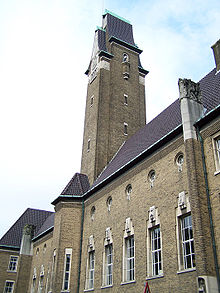
The Faculty of Law, located at the former provincial government building.
Maastricht University has two campuses: the city centre campus, consisting of a number of historic buildings housing the humanities and social sciences faculties, and the modern Randwyck campus in the southeastern part of the city, which has become the university’s centre for the medical, health, psychology and life sciences. The Randwyck campus includes the university hospital. Initial plans in the 1960s and 1970s, in line with infrastructural plans at other public universities in the Netherlands, envisaged a functional, single-campus university to be established in the largely undeveloped Randwyck district. These plans never fully materialized, in part because university administrators and staff considered the UM’s presence in the historic inner city to be important asset in attracting prospective students. Instead, the university developed in a bipolar way with campuses at both sides of the river Meuse. This bipolarity is symbolized in the university's logo by two triangles pointing to each other.
In recent years, the university has opened offices in the northern Limburg city of Venlo, the Belgian capital of Brussels and the city of Bangalore, India.
City Centre 校园
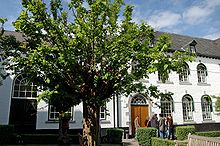
The courtyard at Nieuwenhof, home of University College Maastricht.
The university’s humanities and social sciences faculties are located in Maastricht’s city centre, west of the river Meuse, at what can be described as an 'urban campus’ in the historic inner city. In addition to teaching and research facilities, the university’s executive and administrative centre, the visitors’ centre and the main branch of the university library are situated here. Most UM facilities in the city centre are situated in the Jekerkwartier neighbourhood, the southwestern part of the inner city sometimes referred to as Maastricht’s university quarter. Most of the university’s inner city properties have official monumental status. As many of these buildings were facing abandonment at the time of their acquirement, the development of an urban university campus has contributed significantly to the preservation and liveliness of Maastricht’s historic city centre.
The first building to be obtained by the university is the former Jesuit monastery at the Tongersestraat, where in 1974, the newly established medical school started its first academic year. After the medical faculty moved to the newly constructed university hospital, this large building complex, constructed in 1939, became home to the economics faculty, which is the university’s largest academic unit in terms of student numbers. The building was expanded in the 1990s to include the university restaurant (‘mensa’) and a large lecture hall (‘collegezaal’). The Faculty of Law is housed in the former provincial government building (Oud Gouvernement) at the Bouillonstraat (Nos. 1-3), which was constructed in 1935 and was acquired by the UM in 1986 after the provincial government had moved to its new building in the southeastern part of the city.
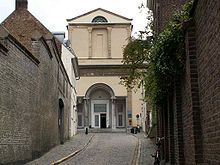
The university's executive building at the Minderbroedersberg.
University College Maastricht is located in the 15th-century Nieuwenhof convent, situated at the Zwingelput. The Maastricht Graduate School of Governance has moved into the recently renovated Hustinx Mansion (1882) at the Kapoenstraat, which has a richly ornamented façade and a covered courtyard. The only faculty in the inner city which is not located in the Jekerkwartier neighbourhood is the Faculty of Arts and Social Sciences. This faculty, founded in 1994, was initially housed at the Hustinx building, but currently occupies two historic, adjacent buildings north of the Vrijthof square: Tilly Court, built in 1714 as the residence for the military governor of Maastricht, and Soiron Canon’s House (1786), located at the Grote Gracht.
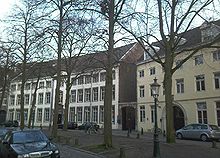
The university library's inner city branch at the Grote Looiersstraat.
The university’s administrative headquarters is located in the Minderbroedersberg building, which dates back to 1699 and was originally built as a Franciscan monastery, was later used as a prison, and served as the regional court house for most of the twentieth century. The UM acquired the building to become its administrative head office in 1999. The Minderbroedersberg and the university’s executive organization located here are colloquially referred to as ‘de Berg’ (the Hill) by university employees for its physical location upon a small hill in the inner city, overlooking several other inner city locations. The building complex, especially its ‘Aula’ (main hall), also serves as the university’s primary location for official academic ceremonies, such as Ph.D. defenses. Down the hill, at the former Bonnefanten Convent, is the university’s visitors centre, which also houses the student service centre, administrative offices, the university gift shop and a coffee house. This building, which dates back to 1627, served as a convent until 1798 and was afterwards for military purposes. In the twentieth century, the city’s main art museum, the Bonnefantenmuseum, was established here. It became the main branch of the university library in 1979, until the library moved to its current location at the Grote Looiersstraat.
The library building at the Grote Looiersstraat was constructed in 1755 and after serving as the city’s poor house for a few years, it was transformed into a military hospital which it remained until the 1920s. Later, the building housed the city’s public library until 1999, when it moved to its new location in the modern Ceramique district. The building was then acquired by the UM. After major renovation and expansion works, which included a new entrance at the courtyard, the university library relocated here in 2003.
Randwyck 校园
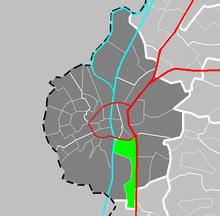
The Randwyck district in the southeastern part of Maastricht.
The Randwyck campus, developed since the 1970s, has become the centre for the university’s medical and life sciences. The focal point for the Randwyck campus is the sprawling university hospital, which moved from its original location in the western part of Maastricht to its current site in Randwyck in 1992. The main university buildings, some of which are physically connected to the hospital, were built in the 1990s. Most sites have been constructed along the Universiteitssingel, the area’s eastern thoroughfare running parallel to the A2 highway. The medical faculty, the first to move to the Randwyck district, merged with the Faculty of Health Sciences in 2007 to become the Faculty of Health, Medicine and Life Sciences. The other faculty currently housed at Randwyck is the Faculty of Psychology and Neuroscience. The university library's Randwyck branch is located at Universiteitssingel 50.
In the early 1980s, when it became clear that the university would not relocate to Randwyck in its entirety, the city decided that the area would become a business district. In the 1980s and 1990s, the city approved several large infrastructural projects, such as the new provincial government building along the river Meuse and the MECC convention centre, as well as the construction of office buildings and a small residential area in the district.
In 2008, local housing association Servatius began construction for a campus project entitled 'Campus Maastricht', to be built at a site near the university hospital. The ambitious project, designed by Spanish architect Santiago Calatrava, would provide for an athletic centre, student housing, guesthouses, retail facilities and office space. The project was criticized early on for its environmental impact as a result of its abundant use of copper. Soon after the start of construction, it became clear that the projected costs of the campus, estimated at € 165 mln, were unrealistic. Servatius, having failed to secure additional investments, came under heavy political pressure and was forced to put the project on hold in May 2009. In November 2009, the housing association announced that it had cancelled the campus project with immediate effect, as continuation would impair its ability to carry out its principle function to provide social housing in Maastricht.
Organisation
Governance
As is common in the Netherlands, Maastricht University's teaching and research programmes are primarily carried out along the lines of faculties. Within faculties, teaching and research activities may be further decentralised through departments, schools, institutes or colleges. The names of organizational (sub)units, however, do not necessarily indicate their position within the university’s organizational hierarchy. In 2009, for example, the Faculty of Economics and Business Administration was renamed School of Business and Economics, even though it maintains the rank of a faculty.
Faculties are governed by a faculty board, headed by a dean. The dean has overall responsibility for policy and management at the faculty. Each faculty has a faculty council, a representative body the members of which are appointed for annual or biannual terms on the basis of elections by the faculty’s staff and students. Faculty councils have a limited number of decision-making powers as well as general advising responsibilities regarding the faculty’s teaching and research programmes and in organisational and budgetary matters. In addition to the faculty boards and faculty councils, other bodies may be created within faculties for advising or consultation purposes.
At the central level, the university is governed by the Executive Board, consisting of a President, a Vice-President and a Rector. The Executive Board appoints faculty deans, other administrators and professors and has general management responsibilities. The University Council, an elected body representing all members of staff and students at the university, performs functions similar to those of faculty councils. The Board of Deans, consisting of all faculty deans and the Rector, acts as a coordinating and consulting body at the central level and is responsible for awarding doctoral degrees and honorary doctorates.
Additional services at the university are provided by a number of central service centres, such as the university library, the language centre and the university catering department.
Tuition and Financial Assistance
Tuition fees at Maastricht University vary, depending on nationality and programme of study. Regular tuition fees for public universities in the Netherlands are determined annually by law. Maastricht's tuition fees are therefore similar to those at other Dutch public universities. Yearly tuition fees for Maastricht's bachelor's and master's programmes currently amount to € 1,620 for full-time students under the age of 30. Students over the age of 30 pay € 2,058 annually. Under European regulations, in-state tuition levels are also applicable to foreign students from the European Economic Area, which includes all European Union member states. Tuition for students from non-EEA countries is € 8,000 annually for bachelor's programmes and € 11,500 annually for master's programmes.
Dutch students are eligible for national student grants and loans, administered by the Dutch government. International students normally are not eligible for student grants, but students from EEA countries are usually eligible for loans to cover tuition fees. Unlike several other Dutch universities, Maastricht University is not in the US Department of Education list of approved schools for US student aid (FAFSA) funding purposes. UM administers several university-wide scholarship programmes for international students, including the UM High Potential Scholarships, UM Company Scholarships and Friends Make the Difference Scholarships. Annually, the top 3% of UM students with the highest overall grades are awarded a full refund of their tuition. The Limburg University Fund, a fundraising foundation associated with the UM, administers a scholarship fund for students from emerging markets. A special fund was created to support students from Southeast Asian countries hit by the 2004 tsunami.
As is common in the Netherlands, Ph.D. candidates ('promovendi') at Maastricht University typically are not considered students and accordingly do not pay tuition. Instead, they have the rank of junior members of the academic staff. Such Ph.D. candidates are employed by the university or faculty on full-time, four-year contracts with regular, entry-level wages and employee benefits. Ph.D. appointments usually involve teaching responsibilities and limited administrative duties.
Faculties
Faculty of Arts and Social Sciences
The Faculty of Arts and Social Sciences offers two bachelor programmes, seven undergraduate minors, eight postgraduate programmes, and has a Graduate School for Ph.D. students. These programmes are:
- B.A. degree programmes: Arts and Culture, European Studies
- Minor: Arts and Culture, Crucial Differences, European Studies, Globalisation and Diversity, Governing Europe, Law and Policy Making, Living with the Life Sciences
- M.A. degree programmes: Analysing Europe, European Studies, European Public Affairs, Arts and Heritage: Policy, Management and Education; European Studies on Society, Science and Technology; Arts and Sciences, Media Culture,
- M.Phil degree programmes: Cultures of Arts, Science and Technology
- Ph.D. degree programmes: Arts and Social Sciences
School of Business and Economics
The Maastricht University School of Business and Economics is currently accredited by EQUIS (press release), AACSB (press release) and Association of MBAs (AMBA). This Triple Crown accreditation has only been achieved by 28 other business schools, including RSM Erasmus University, INSEAD, IMD, FGV(Brazil), and the London Business School. Students from the Maastricht University School of Business and Economics have also successfully participated in the case competitions at McGill University (MMICC) and the University of Southern California (USC) in 2006 (website). In 2007, the university was once again invited and participated at CBS Case Competition ([1]).
Faculty of Law
The Maastricht Law Faculty offers bachelor (LLB) and master programmes (LLM) in both English and Dutch. It is renowned internationally for its European Law School, an English-taught programme that focuses on European, international and comparative law. Using practice-oriented teaching in small-scale groups, the Maastricht Law Faculty satisfies the labour market’s increasing demand for lawyers who are trained to solve European and cross-border legal problems.
LLB: Dutch Law; Tax Law; European Law School.
LLM: European Law School, Globalisation and Law; International Laws; Tax Law (including International and European Tax Law); Forensics, Criminology and Administration of Justice; Dutch Law; Law and Labour.
Advanced (postgraduate) Master programmes: Advanced Master in Intellectual Property Law and Knowledge Management (LLM/MSc); Advanced Master in International and European Economic Law (LLM).
Faculty of Humanities and Sciences
The Faculty of Humanities and Sciences consists of:
- University College Maastricht (UCM)
- Department of Knowledge Engineering (DKE)
- International Centre for Integrated Assessment and Sustainable Development (ICIS)
- Maastricht Graduate School of Governance
Faculty of Health, Medicine and Life Sciences
The Faculty of Health, Medicine and Life Sciences started January 1, 2007. The faculty was the result of a merger between the Faculty of Health Sciences and the Faculty of Medicine. The Faculty of Medicine was the first Faculty to be established at Maastricht University. The University was officially established on the 9th of January 1976, although the first medical students began their studies in September 1974.
The Faculty developed into a community with a staff of around 1200 (academics, administrative and support staff), and approximately 1950 medical students. Since 1992 staff and students are based at the complex of buildings of the Faculty of Health, Medicine and Life Sciences, Faculty of Psychology, and the University Hospital (Academic Hospital Maastricht) which opened in 1991.
The Faculty of Health Sciences offered a broad range of disciplines that made the faculty unique. Not only in the Netherlands, but also in Europe. The format allowed students to integrate their discipline and research work into all areas related to society, sickness and health. By way of research and specific (undergraduate and postgraduate) education, the Faculty of Health Sciences contributed to quality improvement in health care.
Faculty of Psychology and Neuroscience
Founded in 1995, Maastricht University’s Faculty of Psychology and Neuroscience (FPN) is specialised in two contemporary angles in psychology: cognitive psychology and biological psychology. Like all those at Maastricht University, its programmes revolve around Problem-Based Learning (PBL).
Teaching
Teaching at Maastricht University is founded on the educational principles of problem-based learning (PBL). According to its website, UM is the only university which applies the problem-based learning approach in all its educational programmes. In 1974, Maastricht's newly-established Faculty of Medicine was only the second in the world to adopt the problem-based learning method. As PBL was originally designed for medical education, other faculties have developed a PBL approach that corresponds with the needs of their academic disciplines.
At the heart of Maastricht's PBL philosophy is the idea that students are personally responsible for their own academic education. A typical UM course revolves around so-called 'tutorial groups'. A tutorial group usually consists of 14 to 16 students, meeting once or twice a week to discuss self-identified problems on the basis of cases or situations described in the course manual. Each tutorial meeting consists of two parts: a post-discussion, where problems which have been identified at the previous session are discussed on the basis of assigned literature and sometimes with additional library research, followed by a pre-discussion of topics to be discussed at the next meeting. The tutorial group is chaired by a student member, who is expected to structure the discussion and ensure that every member of the group is able to participate. The instructor, typically named 'tutor', plays only a limited role during tutorials. Tutors will monitor discussions, provide feedback, and, where needed, help students in identifying relevant problems. Courses usually take seven weeks of tutorials followed by a final exam, but may also include writing or speaking assignments.
Even though traditional lecture-based teaching is at odds with the primarily self-guiding PBL approach, it has become customary in many programmes at Maastricht to include at least some lectures in courses to supplement the tutorial-based structure. Also, electronic learning methods are increasingly being used. As PBL courses are intensive, students can take only two or three courses at a time depending on the number of credit hours per course. The university's Language Centre offers an introduction to Maastricht's PBL approach for international students.
Academic Life
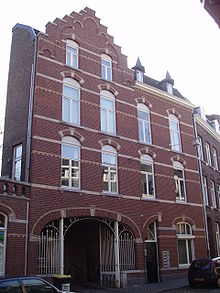
Student housing complex in the city centre, owned by Woonpunt housing association.
The Maastricht University student body is still composed primarily of students from the Netherlands, but UM has a sizable number of international students. Of the 13,117 registered students in 2008, 39% were of a foreign nationality. Most foreign students are from European Union member states: 4,794 students, or 37% of the total student body. Other, non-EU foreign students, amounting to less than 2% of the total number of UM students, came from various countries in Europe (91), Asia (129), Africa (45), North America (33), Central and South America (15), and Oceania (29). The university attracts a significant number of German students, especially in its economic, European Studies and psychology programmes. About 800 students annually choose Maastricht as their study abroad destination, while about 1,400 Maastricht students spend one or more semesters at a foreign university each year. Some 70 nationalities are currently represented at UM.
Maastricht University's academic staff, which has been growing over the past years, consists of about 1,900 members with a male/female ratio of 54/46. The number of support staff members amounts to 1,600, of which about 62% is female. Nearly 20% of UM's staff members hold a foreign nationality. About 12% of professors at Maastricht University are women. Regarding the number of female professors, the university ranks lower than comparable universities in the Netherlands even though the number has been on the increase over the past years.
Like most other Dutch universities, UM itself does not provide regular student housing. However, the university participates in a student housing foundation, offering mediation services to students. About 2,700 rooms and apartments offered through the Maastricht student housing foundation are provided by local housing associations Woonpunt, Servatius and Maasvallei. Some 8,000 other accommodations are provided by private landlords. Most units are located in houses or small apartment complexes across the historic city centre or in its immediate surrounding neighbourhoods. Many foreign exchange students live at the UM Guesthouse in Annadal, which provides short-term housing. Student accommodations are usually rented out unfurnished, but the number of furnished rooms is growing to meet the demands of the increasing number of international master's students in Maastricht.
The university's independent newspaper, Observant, is published on a weekly basis and distributed throughout the university. It provides news, background articles, columns and educational information in Dutch and English, directed primarily at the university community. Studium Generale, the university's cultural office, organizes lectures and cultural activities for members of the university community and the general public.
Research
The University's main research centres are:
- CaRe Netherlands School of Primary Care Research
- CARIM http://carim.unimaas.nl (Cardiovascular Research Institute Maastricht) Heart and Vascular diseases
- EPP Research School Experimental Psychopathology
- EURON EUROpean Graduate School of Neuroscience
- Ius Commune [2]
- METEOR Maastricht Research School of Economics of Technology and Organisations
The UM participates in the following research schools:
- Huizinga Institute UM participation in the research institute CWS
- ICO UM participation in the research Institute of Medical Education
- iBME integrated Biomedical Engineering. Co-operation with the University of Twente.
- SIKS UM participation in the Department of Knowledge Engineering
- School for Human Rights Research [www.law.uu.nl/English/orm/]
- VLAG Nutrition, food Technology, Agro-biotechnology and Health
- WTMC Netherlands Graduate School of Science, Technology and Modern Culture
Research institutes:
- CAPHRI Care and Public Health Research Institute
- CARIM Cardiovascular Research Institute Maastricht
- CWS Arts and Culture Research
- EPP Experimental Psychopathology
- GROW Research Institute Growth & Development
- H&G Maastricht Brain & Behaviour Institute.
- ICIS International Centre for Integrative Studies
- IGIR Institute for Globalisation and International Regulation
- MARC - Maastricht Accounting, Auditing & Information Management Research
- Maastricht Centre for Human Rights
- METRO Maastricht European Institute for Transnational Law Research
- METEOR Maastricht Research Institute/School of Economics and Organizations
- Montesquieu Institute (Centre for European Parliamentary History and Constitutional Development)
- NUTRIM Nutrition and Toxicology Research Institute Maastricht
- ROA Research Centre for Education and the Labour Market
- UNU-MERIT (Maastricht Economic and social Research and training centre on Innovation and Technology), UNU-MERIT is also part of the United Nations University
There are faculty research units and associated institutes (research website)
Rankings
- The Times Higher Education Supplement (THES) university ranking: place 111 in 2007 and again in 2008; 172 in 2006. Ranked 40 in Europe in 2008. In the category foreign students, Maastricht University scored 99/100, placing it 5th in Europe (cf. Harvard 91/100).
- The Russian based Global University Ranking, which combines methodology of several rankings, placed Maastricht among top 100 universities in the world in 2009.
- Dutch Ministry of Education, Culture and Science (OC&W): In 2004, Maastricht University was ranked first (of all Dutch Universities) in a report on quality of education (press release). In 2005, the university came in first again. From 2006 onwards, the ministry no longer publishes a ranking list.
- Keuzegids Hoger Onderwijs: In 2006, eight of the twelve bachelor programmes were designated as best programme in the Netherlands by students (European Studies, Economics, Econometrics, International Business, Psychology, Medicine, Health Sciences and Molecular Life Sciences). From the other four programmes, three came in second place.
- Dutch Magazine Elsevier: At the beginning of the academic year 2005-2006 the university was once again ranked number one in the Netherlands by the Dutch publication Elsevier. In 2007 many degrees were again recognized as best in the Netherlands with exceptional grades given to the international opportunities in the International Business and Economics degrees.
- German Magazine Wirtschaftswoche: In 2005, the Faculty of Economics and Business Administration was regarded better than the same faculty at Oxford University (website).
- Financial Times: In 2008 the Faculty of Economics and Business Administration (FEBA) participated in the Financial Times’ ranking for Masters in Management programmes for the first time and its International Business programme scores a 25th place in the top 40 of European institutes that offer such programmes: website. The programme even made the 4th place on the list "Best in International Business" and 3rd in the category "Value for Money" website.
- Its undergraduate degrees in International Business and Economics were ranked 1st in the Netherlands in the 2008 Elsevier ranking Announcement
Notable Professors
- Wiebe Bijker: Professor of Technology and Society, member of the KNAW (Royal Netherlands Academy of Arts and Sciences) and together with Trevor Pinch the founder of Social Construction of Technology (SCOT)
- Franz Palm: Professor of Econometrics, member of the KNAW (Royal Netherlands Academy of Arts and Sciences)
- Maurits Allessie: Professor of Physiology, member of the KNAW (Royal Netherlands Academy of Arts and Sciences)
- Andre Knottnerus: Professor of General Practice, member of the KNAW (Royal Netherlands Academy of Arts and Sciences), President of the Health Council of the Netherlands
- Luc Soete: Professor of General Economics, Director of research institute UNU-MERIT (which is also part of the United Nations University), member of the group of key thinkers for the Lisbon Strategy
- Geert Hofstede: Emeritus Professor of Organizational Anthropology and International Management. Founder of Institute for Research on Intercultural Cooperation (IRIC)
- John Hagedoorn: Professor of Strategy and International Business and professorial fellow with the United Nations University - MERIT
- Theo van Boven: Professor Emeritus of International Law, Former UN Director for human rights and UN Special Rapporteur for Torture
- Rainer Goebel: Professor of Neurocognition, Director of the Maastricht Brain Imaging centre, Winner of the German Heinz-Maier-Leibnitz award for cognitive sciences in 1993
- Peter Van den Bossche: Professor of International Economic Law; Head of Department, International & European Law; Director, Institute for Globalisation & International Regulation (IGIR); Formerly, Counsellor to the WTO Appellate Body and Acting Director, WTO Appellate Body Secretariat. Commencing 12 December 2009, Van den Bossche has been appointed for a 4 year term to the 7-member Appellate Body of the WTO.
参考文献
- ^ "Belangrijke UM-data" (in Dutch). Maastricht University. 2009-01-21. http://www.maastrichtuniversity.nl/web/Main1/OverDeUM/GeschiedenisUniversiteitMaastricht/BelangrijkeUMdata.htm. Retrieved 2009-06-28.
- ^ "Statistics". Maastricht University. 2008-08-25. http://www.maastrichtuniversity.nl/web/Main/AboutUM/FactsFigures/Statistics.htm. Retrieved 2009-06-28.
- ^ "About UM". Maastricht University. 2008-07-01. http://www.maastrichtuniversity.nl/web/Main/AboutUM.htm. Retrieved 2009-07-18.
- ^ "Universiteit". Zicht op Maastricht. http://www.zichtopmaastricht.nl/tekst/onderwerpen/universiteit. Retrieved 2009-12-31.
- ^ Staatsblad (‘’Official Journal’’) 1975, 717.
- ^ "History". Maastricht University. http://www.maastrichtuniversity.nl/web/Main/AboutUM/History.htm. Retrieved 2010-01-09.
- ^ Beijer, Hans et al. (2006). MonUMent, published to mark the thirtieth anniversary of the founding of Maastricht University.
- ^ Beijer, Hans et al. (2006). MonUMent, published to mark the thirtieth anniversary of the founding of Maastricht University.
- ^ "Bijna niemand wil deze koperen campus". de Volkskrant. 2007-06-26. http://www.volkskrant.nl/archief_gratis/article589761.ece/Bijna_niemand_wil_deze_koperen_campus. Retrieved 2010-01-08.
- ^ "Maastricht Campus Stop". Rhine Meuse Journal. http://www.meuse-rhine-journal.com/html/Bus_20091111102310.html. Retrieved 2010-01-09.
- ^ "‘Copper’ campus: disappointment and reproach". Observant Online. http://www.observantonline.nl/Artikelen/tabid/69/agentType/View/PropertyID/898/Default.aspx. Retrieved 2010-01-08.
- ^ "UM Organisation". Maastricht University. http://www.maastrichtuniversity.nl/web/Main/UMOrganisation.htm. Retrieved 2010-01-24.
- ^ "UM Organisation Chart". Maastricht University. http://www.maastrichtuniversity.nl/web/Main/UMOrganisation1/UMOrganizationChart.htm. Retrieved 2010-01-24.
- ^ "Faculty Board". Maastricht University. http://www.maastrichtuniversity.nl/web/Main/UMOrganisation1/UMOrganisation/FacultyStructure/FacultyBoard.htm. Retrieved 2010-01-24.
- ^ "Faculty Structure". Maastricht University. http://www.maastrichtuniversity.nl/web/Main/UMOrganisation1/UMOrganisation/FacultyStructure.htm. Retrieved 2010-01-24.
- ^ "Faculty Council". Maastricht University. http://www.maastrichtuniversity.nl/web/Main/UMOrganisation1/UMOrganisation/FacultyStructure/FacultyCouncil.htm. Retrieved 2010-01-24.
- ^ "Executive Board". Maastricht University. http://www.maastrichtuniversity.nl/web/Main/UMOrganisation1/UMOrganisation/UMAdministrativeStructure/ExecutiveBoard.htm. Retrieved 2010-01-24.
- ^ "University Council". Maastricht University. http://www.maastrichtuniversity.nl/web/Main/UMOrganisation1/UMOrganisation/UMAdministrativeStructure/UniversityCouncil1.htm. Retrieved 2010-01-24.
- ^ "Board of Deans". Maastricht University. http://www.maastrichtuniversity.nl/web/Main/UMOrganisation1/UMOrganisation/UMAdministrativeStructure/BoardOfDeans1.htm. Retrieved 2010-01-24.
- ^ "Service Centres". Maastricht University. http://www.maastrichtuniversity.nl/web/Main/UMOrganisation1/ServiceCentres.htm. Retrieved 2010-01-24.
- ^ "Tuition fees 2009-2010". Maastricht University. http://www.maastrichtuniversity.nl/web/ServiceCentres/SSC/InformationForProspectiveStudents1/AboutApplicationAndRegistration1/TuitionFees/TuitionFees20092010.htm. Retrieved 2010-02-06.
- ^ "Tuition fees 2009-2010". Maastricht University. http://www.maastrichtuniversity.nl/web/ServiceCentres/SSC/InformationForProspectiveStudents1/AboutApplicationAndRegistration1/TuitionFees/TuitionFees20092010.htm. Retrieved 2010-02-06.
- ^ "Student grant". Netherlands Ministry of Education. http://www.ib-groep.nl/International_visitors/student_grant/student_grant.asp. Retrieved 2010-02-06.
- ^ "Federal School Code Search". U.S. Department of Education. http://www.fafsa.ed.gov/FOTWWebApp/FSLookupServlet. Retrieved 2010-02-06.
- ^ "Scholarships for prospective international students". Maastricht University. http://www.maastrichtuniversity.nl/web/ServiceCentres/SSC/Scholarships1.htm. Retrieved 2010-02-06.
- ^ "The Scholarship Fund". Maastricht University, Limburg University Fund. http://www.maastrichtuniversity.nl/web/Main/Donors/Projects/TheScholarshipFund.htm. Retrieved 2010-02-06.
- ^ "PhD Positions". Maastricht University. http://www.maastrichtuniversity.nl/web/Main/Research/PhD/PhDPositions.htm. Retrieved 2010-02-06.
- ^ "Problem-Based Learning". Maastricht University. http://www.maastrichtuniversity.nl/web/Main/Education/EducationalProfile/ProblemBasedLearning.htm. Retrieved 2010-02-07.
- ^ "Problem-Based Learning". Maastricht University. http://www.maastrichtuniversity.nl/web/Main/Education/EducationalProfile/ProblemBasedLearning.htm. Retrieved 2010-02-07.
- ^ "Tutorial groups". Maastricht University. http://www.maastrichtuniversity.nl/web/Main/ProspectiveStudents/BachelorsProgrammes/EducationalProfile/TutorialGroups.htm. Retrieved 2010-02-07.
- ^ "Tutors". Maastricht University. http://www.maastrichtuniversity.nl/web/Main/ProspectiveStudents/BachelorsProgrammes/EducationalProfile/Tutors.htm. Retrieved 2010-02-07.
- ^ "How to survive Maastricht". Observant. 2009-06-04. http://www.observantonline.nl/Artikelen/tabid/69/agentType/View/PropertyID/316/Default.aspx. Retrieved 2010-02-07.
- ^ "Jaarverslag 2008 (Annual Report 2008)". Maastricht University. http://www.maastrichtuniversity.nl/web/Main1/OverDeUM/FeitenCijfers/Jaarverslag.htm. Retrieved 2010-01-31.
- ^ "Jaarverslag 2008 (Annual Report 2008)". Maastricht University. http://www.maastrichtuniversity.nl/web/Main1/OverDeUM/FeitenCijfers/Jaarverslag.htm. Retrieved 2010-01-31.
- ^ "Educational Refugees - How German students exchange bratwurst for gouda". American Chronicle. 2009-01-09. http://www.americanchronicle.com/articles/view/87332. Retrieved 2010-01-31.
- ^ "Jaarverslag 2008 (Annual Report 2008)". Maastricht University. http://www.maastrichtuniversity.nl/web/Main1/OverDeUM/FeitenCijfers/Jaarverslag.htm. Retrieved 2010-01-31.
- ^ "Over de UM (About UM)". Maastricht University. http://www.maastrichtuniversity.nl/web/Main1/OverDeUM1.htm. Retrieved 2010-01-31.
- ^ "Facts and Figures: Staff". Maastricht University. http://www.maastrichtuniversity.nl/web/Main/AboutUM/FactsFigures/MaastrichtUniversityStatistics/Staff.htm. Retrieved 2010-01-31.
- ^ "Facts and Figures: Staff". Maastricht University. http://www.maastrichtuniversity.nl/web/Main/AboutUM/FactsFigures/MaastrichtUniversityStatistics/Staff.htm. Retrieved 2010-01-31.
- ^ "Monitor Women Professors 2009". De Beauvoir Foundation. 2009-09. http://www.sofokles.nl/downloads/actueel/Monitor_Women_Professors_2009.pdf. Retrieved 2010-01-31.
- ^ "About the Kamerburo". Kamerburo Maastricht. http://www.kamerburo.net/content/about.asp?lang=uk&task=over. Retrieved 2010-01-31.
- ^ "New accommodation for master's students". Observant. 2009-09-24. http://www.observantonline.nl/Artikelen/tabid/69/agentType/View/PropertyID/641/Default.aspx. Retrieved 2010-01-31.
- ^ "Observant newspaper". Maastricht University. http://www.maastrichtuniversity.nl/web/Main/ProspectiveStudents/BachelorsProgrammes/ServicesFacilities/ObservantNewspaper.htm. Retrieved 2010-01-31.
- ^ "General Information". Studium Generale, Maastricht University. http://www.sg.unimaas.nl/info.asp?lang=en. Retrieved 2010-01-31.
- ^ Research Institutes - UM research - Research - Universiteit Maastricht
- ^ http://www.globaluniversitiesranking.org/images/banners/top-100(eng).pdf
- ^ "Peter Van den Bossche appointed as WTO Appellate Body Judge". Maastricht University. (2009-05-28). http://www.maastrichtuniversity.nl/web/Main/Sitewide/Content/AppointmentPeterVanDenBossche.htm. Retrieved 2010-04-10.
External links
 |
Wikimedia Commons has media related to: Maastricht University |
- Maastricht University website
- Onafhankelijk (weekblad van de Universiteit Maastricht) (english)



